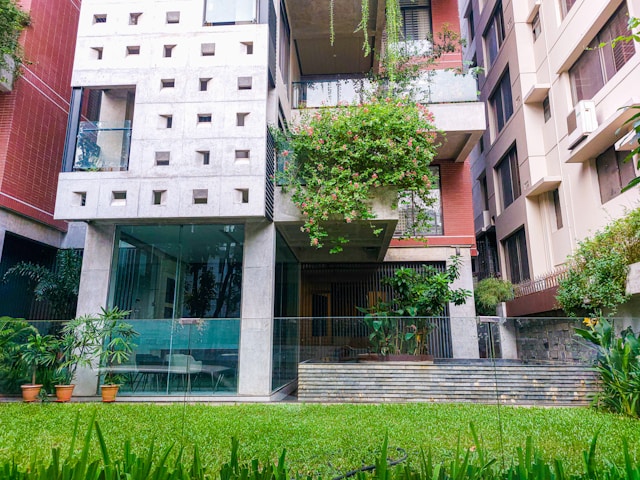Enhancing Property Value and Reducing Environmental Impact With Green Building

In 2022, the commercial and residential sectors alone accounted for over 13% of the greenhouse gas emissions in the United States. This statistic serves as a stark reminder of the urgent need to embrace sustainable solutions in the construction industry.
In today’s world, environmental awareness is crucial. Green building practices are a smart investment for property owners and a responsible choice for our planet.
Understanding Green Building Beyond the Buzzword
Green building refers to the design, construction, and operation of buildings in an environmentally responsible way. The core principles of green building include:
- Energy efficiency. Using less energy through efficient heating/cooling systems, proper insulation, ENERGY STAR appliances, etc. This saves money on utility bills.
- Water conservation. Installing low-flow plumbing fixtures, rainwater harvesting systems, and drought-tolerant landscaping to reduce water usage.
- Sustainable materials. Choosing recycled, renewable, and non-toxic materials that are responsibly sourced.
- Indoor environmental quality. Using low-VOC paints/finishes, adequate ventilation, daylighting, and air filtration to ensure occupant health and comfort.
- Site management. Protecting and restoring the natural environment around the building and managing stormwater runoff.
The benefits of green building extend far beyond environmental stewardship. Studies show that energy-efficient, sustainable buildings have over 20% higher property values and rental rates. They also have lower operating costs and increased occupant productivity.
By going green, property owners future-proof their assets while making them healthier places to live and work.
Financial & Environmental Green Advantages
The financial benefits of green building are recognized globally. Even in regions with high energy demands like the UAE, sustainable properties are seeing increased interest and value. According to Dubai government statistics, the number of buildings that meet green building specifications in Dubai reached 72,000 by the second quarter of 2023, representing 58% of all buildings.
Green-certified properties often have higher resale values and sell faster than conventional buildings. A recent study found that LEED-certified commercial buildings sold for over 20% more per square foot. Energy retrofits can also yield returns as high as 20% by reducing operating expenses.
For those looking to buy property in Dubai, exploring green building options can be a wise investment strategy. You’ll enjoy the financial rewards of lower operational costs, increased property value, and a more marketable asset.
Beyond financial incentives, green buildings reduce environmental impact by lowering energy use, carbon emissions, and waste. Energy-efficient HVAC, lighting, appliances, and building materials like low-VOC paint and recycled flooring create healthier indoor environments.
Green Building in Practice
Constructing green buildings involves utilizing sustainable design, materials, and operations. Some key features may include:
- Energy efficiency.
- Renewable energy.
- Water conservation.
- Waste reduction.
- Non-toxic materials.
- Access to natural light and ventilation.
For property owners, green buildings can boost asset value and attract eco-conscious tenants. Energy and water savings also reduce operating expenses. Green retrofits and renovations allow upgrading existing buildings to be more sustainable.
High-efficiency HVAC systems provide superior temperature and humidity control. Abundant daylight, fresh air circulation, low VOC materials, and moisture control create cleaner indoor air quality and reduce exposure to allergens and irritants.
Green features directly impact residents’ lifestyles. Energy-efficient appliances and lighting reduce utility bills. Renewable energy from solar panels or wind turbines means relying less on fossil fuels. Water-saving plumbing fixtures conserve resources.
Green buildings provide a strong sense of environmental responsibility. The green features allow residents to walk the talk of environmental responsibility.
With economic, health, and environmental benefits, green building practices lead to higher-performing, more valuable properties. Implementing sustainability measures is an investment that pays dividends across the board.
Green Considerations for Buyers & Renters
If you want to buy or rent a green property, do your homework first. Here are some points that can make up your list:
- Look for certifications like LEED, ENERGY STAR, and Net Zero Energy to verify the home’s level of sustainability.
- Check for energy-efficient heating, cooling, appliances, lighting, windows, insulation, and weatherization.
- Seek out renewable energy sources like solar panels or geothermal systems.
- Tour the grounds to ensure drought-tolerant landscaping and on-site water retention.
- Ask about green maintenance practices and supplies.
- Get documentation on past or projected energy usage.
- Question real estate agents and landlords thoroughly to determine how green the property is.
The right green home is out there — knowledge is power when identifying properties that align with your eco-conscious lifestyle.
To Sum Up
Green building offers an opportunity to enhance property value while reducing environmental impact — a win-win for both financial and ecological bottom lines. As climate change progresses, green practices will only gain more relevance. By getting ahead of the curve, builders and owners position themselves for success in a more eco-conscious future.
